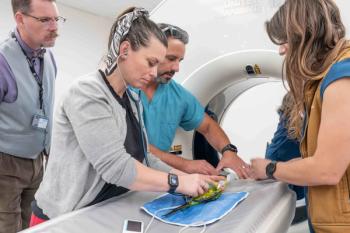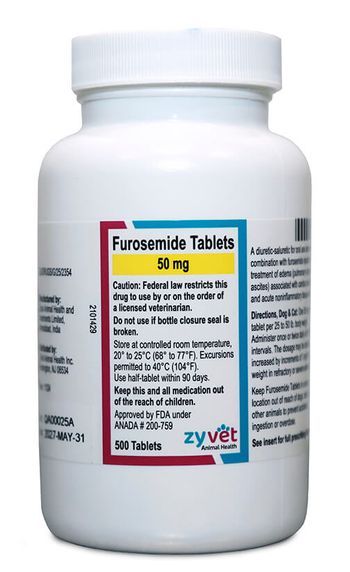
What's wrong with the ticker? (Proceedings)
When performing a complete cardiac evaluation, a minimum of two views are necessary: lateral and either VD or DV.
When performing a complete cardiac evaluation, a minimum of two views are necessary: lateral and either VD or DV. On the lateral projection, you may either choose right or left recumbency, but make sure and always use it on serial radiographic examinations. It is important that the radiographs are not obliqued. A normal heart can appear diseased when positioning is not adequate. When you are evaluating for correct positioning, on the lateral projection, make sure the dorsal heads of the ribs should are superimposed, the forelimbs are pulled forward so that they are nor superimposed over the cranial thorax, and that the radiographic exposure is taken during full inspiration. When obtaining an orthogonal radiograph, realize that the anatomic positioning of the heart in a DV is less dependent on thoracic cavity conformation, the dorsal lung fields are hyperinflated and the vessels to the caudal lung fields are magnified, and a DV view allows increased detection of early pulmonary infiltrates. As a result of the above, a DV view is preferred, however.... a straight symmetric projection is the goal and if a VD view achieves this goal – by all means use it!! To evaluate the DV/VD view, the dorsal spinous processes of the thoracic vertebrae should be centered over the vertebral bodies and the exposure should be sufficient to define the outline of the thoracic vertebrae superimposed over the cardiac silhouette. Radiographic anatomy on the lateral view is easily divided into the cranial border which represents the margins of the right heart and the caudal border which represents the left cardiac chamber margins. The dorsal third of both the cranial and caudal border is the atria and the ventral ⅔ is the ventricle. The "waist" is the separation between the atria and ventricles. The arteries are located dorsal to the veins. The cranial pulmonary arteries and veins should be equal in size to the proximal 4th rib. The clock face analogy is commonly used to show location of important cardiac vessels and chambers on the VD/DV views. The aortic arch is located between 11 and 1o'clock, the main pulmonary artery between 1-2 o'clock, the left auricular appendage 2:30-3 o'clock, the left ventricle between 3-5 o'clock, the right ventricle between 5-9 o'clock, and the right atrium is located between 9-11 o'clock. In dogs, the cardiac apex is usually shifted approximately 30' to the left of midline. The pulmonary arteries are lateral to the veins on the DV/VD view. The caudal vena cava is to the right of midline and the descending aorta summates with the heart and extends into the abdomen to the left of the spine. Radiographic interpretation involves a systematic approach and required that abnormalities be substantiated on multiple radiographic views. Firs and foremost when you begin to evaluate for technical quality, positioning, and proper exposure....if the study is substandard....STOP AND REPEAT THE RADIOGRAPHS! To evaluate a thoracic radiograph – I use the central out approach (cardiac silhouette first, pulmonary vessels, trachea, pulmonary parenchyma, sternum, ribs, vertebrae, cervical soft tissues, and then lastly the abdomen). First, assess the position of the cardiac silhouette. The location of the cardiac silhouette is affected by non-cardiac thoracic pathology such as pulmonary disease (atelectasis from anesthesia or recumbent animal, previous lobectomy), pleural disease (fluid or air), as well as mediastinal mass lesions. All of these alter cardiac position. The cardiac silhouette can be separated from sternum due to hyperinflation of the lungs in a deep chested breed dog - don't be fooled into thinking this is only associated with pneumothorax. Congenital sternal defects (pectus carninum and excavatum) also cause the heart position to vary. Next we evaluate cardiac size. A normal heart on the lateral view is approximately ⅔ the height of the thoracic cavity. The width is between 2.5-3.5 intercostal spaces in a dog and 2.5-3 intercostal spaces in a cat. There are great breed variations in dogs however (dachshunds, yorkies, and pugs). On the DV/ VD view, the width of the heart is approximately ⅔ the width of the thoracic cavity. These rules do not apply to deep chested dogs like Dobermans or collies which have a more "up and down" heart resulting in a round cardiac silhouette on the DV/VD view. Fat in the middle mediastinum in a cat can artifactually cause the cardiac silhouette to appear enlarged. Some other facts to remember with respect to cardiac size.... young animals appear to have larger hearts relative to thoracic size, the heart is smaller on inspiration than expiration, expiration causes increased sternal contact, anemic or emaciated patients have small hearts due to hypovolemia. Cardiomegaly results when one (or more) of the cardiac chambers becomes enlarged. Left atrial enlargement is suspected on the lateral view when there is dorsal elevation of the caudal portion of the trachea and carina, the right and left mainstem bronchi are no longer superimposed (the left bronchus will be more dorsal than the right), ultimately this results in straightening of the caudal cardiac silhouette. On the DV/VD view in a dog, a "double opacity" of the atrial body over the caudal aspect of the cardiac silhouette is seen. The body of left atrium causes lateral bowing of the mainstem bronchi (aka "bow legged cowboy"). In a cat, enlargement of the cardiac margin at the 2-3 o'clock position (Indentation of the caudal cardiac waist). There are numerous causes of left atrial enlargement. Mitral insufficiency from valvular endocardiosis, cardiomyopathy, congenital heart diseases (mitral valve dysplasia, PDA-patent ductus arteriosus, VSD -ventricular septal defects, ASD-atrial septal defects) and left ventricular failure. Tracheobronchial lymph node enlargement and a pulmonary mass adjacent to the cardiac hilus can also cause increased opacity overlying the heart and need to be differentiated from left atrial enlargement. Left ventricular enlargement on the lateral view shows loss of the caudal waist, the caudal cardiac margin is straighter and more vertical than normal, there is dorsal elevation of the intrathoracic trachea, carina, and mainstem bronchi, and the angle between the thoracic spine axis and trachea is diminished to the point of being parallel. On a DV/VD view, rounding and enlargement of the left ventricular margin, rounding of the cardiac apex conformation, and shift of the cardiac apex to the right. Etiologies of left ventricular enlargement include mitral insufficiency, cardiomyopathy, congenital heart diseases (PDA-patent ductus arteriosus, VSD -ventricular septal defects, AS-aortic stenosis), high output cardiac diseases (fluid overload, chronic anemia, peripheral arteriovenous fistula, obesity, and chronic renal disease), hyperthyroidism, and hypertension. Right atrial enlargement is identified on the lateral view by elevation of the trachea, accentuation of the cranial waist, enlargement of the more dorsal margin of the cranial cardiac silhouette. On the DV/VD view, enlargement of the cardiac margin at the 9-11 o'clock position is seen. Causes of right atrial enlargement include right heart failure, tricuspid insufficiency, cardiomyopathy, right atrial neoplasia (such as hemangiosarcoma), other diseases that can mimic right atrial enlargement are cranial mediastinal masses, heart base tumor (common in brachycephalic breeds), tracheobronchial lymph node enlargement, superimposition of the aortic arch or main pulmonary artery, and right cranial or middle lobar pulmonary alveolar consolidation or mass lesion. Right ventricular enlargement appears on the lateral view as increased sternal contact (considered a subjective radiographic sign), elevation of the cardiac apex from the sternum (remember this is normal on a left lateral view), increased cardiac width (rounding of the cardiac silhouette), and disproportionate enlargement of the cranial portion of the cardiac silhouette. On the DV/VD view, right ventricular enlargement appears as enlargement of the cardiac silhouette at the 6- 11 o'clock position, a reverse "D" appearance of the cardiac silhouette (which is caused by the the enlargement and rounded conformation of the right margin causing the left margin by comparison to appear more straight in shape), and shifting of the cardiac apex to the left. Causes of right ventricular enlargement are secondary to left heart failure, tricuspid insufficiency, cardiomyopathy, cor pulmonale, heartworms, congenital heart diseases (PS-pulmonic stenosis, PDA -patent ductus arteriosus, VSD-ventricular septal defect, TOF -tetralogy of Fallot, and tricuspid valve dysplasia. Microcardia (overall small cardiac silhouette) appears as decreased size of the cardiac silhouette with respect to the thoracic cavity size and can be caused by Addison's disease, hypovolemic shock, pericarditis, and tension pneumothorax. Now we need to evaluate the great vessels. Enlargement of the aortic arch and aorta on the lateral view is seen as widening of the dorsal aspect of the cardiac silhouette as well as enlargement of the craniodorsal cardiac margin. On the DV/VD view, widening of the caudal portion of the cranial mediastinum between the 11 and 1 o'clock position. The causes of aortic enlargement are PDA – descending aorta (at 1 o'clock position), aortic stenosis – post stenotic enlargement of the ascending aorta (at 11 o'clock position), and aortic aneurysm (which is uncommon). Other diseases that need to be differentiated from an aortic bulge are aortic knob in geriatric cats, cranial mediastinal mass, thymus ("sail sign" in young dogs), cranial mediastinal fat, and this can also be a normal variation in some dogs.
Enlargement of the pulmonary artery on the lateral view shows protrusion of the craniodorsal heart border while on the DV/VD view, there is a lateral bulge of the cardiac margin at 1-2 o'clock position. The pulmonary artery becomes enlarged with heartworm disease, pulmonary thromboembolism (PTE), cor pulmonale, congenital diseases (pulmonic stenosis, PDA, VSD). Do not diagnose enlargement of the pulmonary artery segment on obliqued DV/VD films, as this can be an artifactual finding, especially in deep chested dogs. The peripheral pulmonary vasculature is evaluated next. Undercirculation is seen as relatively radiolucent lung fields due to decreased pulmonary vascular volume, hyperinflation due to hypoxemia or ventilation/ perfusion mismatch, and pulmonary arteries smaller than corresponding pulmonary vein.
Cardiac causes of pulmonary undercirculation are pulmonic stenosis, tetrology of Fallot, and reverse PDA -with right to left shunting. Differential diagnosis are primary pulmonary pathology (such as emphysema, chronic obstructive pulmonary disease, pneumothorax, pulmonary thromboembolism), vascular undercirculation with hypovolemia and Addision's disease (heart also small), and artifactual causes (overexposure and hyperinflation). With overcirculation, both the pulmonary arteries and veins are enlarged (though the arteries are often large than veins) and pulmonary thoracic opacity is increased due to larger vascular volume. Overcirculation is caused by heartworm disease (arteries > veins), PDA (arteries and veins large), VSD and ASD with left to right shunts (arteries and veins large), congestive heart failure (veins > arteries if mainly left sided, both enlarged if both right and left affected), and fluid overload. Radiographs can appear to be artifactually overcirculated by underexposure and exposure at end expiration. Congestive heart failure appears radiographically different depending if the left side, right side, or both are involved. With left heart failure, there is inadequate left ventricular output into the aorta with diminished acceptance of blood into the left atrium resulting in pulmonary venous congestion and leakage of fluid into pulmonary interstitium. This is seen as left sided cardiomegaly (concentric hypertrophy (due to AS), acute arrhythmias, and thin wall cardiomyopathies (DCM) may not have dramatic radiographic left heart enlargement however), pulmonary venous congestion, interstitial edema (results in indistinct visualization of pulmonary vessels), and at times alveolar edema (air bronchograms appear as black tubes in white radiopaque background). Cats commonly get pleural fluid with left sided heart failure. Differential diagnosis for cardiogenic pulmonary edema: neurogenic edema (electrocution, head trauma, post seizure), hyperdynamic (choking, strangulation, upper airway obstruction), fluid overload (overhydration), toxicity, systemic shock, and drowning
Right heart failure is caused by inadequate right ventricular output into pulmonary artery with reduced acceptance of systemic venous flow into right atrium. This results in hepatic venous congestion, then pleural and peritoneal fluid (and sometimes pericardial fluid as well). Radiographic signs are right sided cardiomegaly (concentric hypertrophy (due to PS), acute arrhythmias, and thin wall cardiomyopathies (DCM) may not have dramatic right sided cardiac enlargement), hepatomegaly, ascites, pleural effusion with visualization of interlobar fissures, and separation of visceral pleural margins away from thoracic wall. Causes of right heart failure include decompensated PS, TOF, mitral and tricuspid insufficiency, caval syndrome associated with heartworm disease, pericardial effusion with tamponade, and restrictive pericarditis. Other differentials for pleural effusion (other than congestive right heart failure) are pleuritis, chylothorax, hemothorax, pyothorax, hypoproteinemia, and neoplasia. Lastly, lets consider and enlarged or fluid filled pericardial space. Radiographic signs of pericardial fluid include a generalized basketball-like enlargement of the cardiac silhouette, increased sternal contact of the cranial cardiac margin, a convex bulging of the caudal margin without straightening of the cardiac waist characteristic of left atrial and ventricular enlargement, elevation and enlargement of the caudal venal cava, dorsal elevation of the trachea, hepatomegaly, ascites, and pleural effusion due to right heart tamponade. Now we can begin to review acquired cardiac diseases. The most common heart disease in dogs is valvular endocardiosis. It is caused by degeneration of the valve leaflets, resulting in valve dysfunction and reflux of blood into the atrium during ventricular systole. When the left atrioventricular valve (mitral) is affected left atrial and ventricular enlargement ensues. Left heart failure can result. When the right AV valve (tricuspid) is insufficient, right atrial and ventricular enlargement and right heart failure result. Left and right AV valve insufficiency simultaneously is common. This disease occurs in small to medium sized breeds. Heartworm disease is the most common cause of acquired cor pulmonale. Perivascular fibrosis follows pulmonary hypertension and the disease becomes self-perpetuating to the extent that progressive cardiovascular changes may occur even after the parasites are no longer present. Radiographic signs of heartworm disease are right ventricular and atrial enlargement, enlargement of the main pulmonary artery segment, enlarged, pruned, and tortuous pulmonary arteries, pulmonary infiltrates (may be interstitial, bronchial, alveolar and nodular), finally right heart failure (hepatomegaly, ascites) can result.
There are two types of myocardial diseases. Canine dilated cardiomyopathy (DCM) is a primary myocardial disease that is characterized by cardiac chamber dilation and systolic ventricular dysfunction due to impaired myocardial contractility. This affects primarily large and giant breed dogs. Radiographically, generalized cardiomegaly is present (left atrial, left ventricular and/or biventricular dilation). With feline cardiomyopathy, radiographs cannot differentiate diseases. Hypertrophic (HCM) is thickening of the left ventricular walls such that the left ventricular lumen is small. This can be idiopathic, secondary to systemic hypertension, or caused by hyperthyroidism. HCM can produce the classic "valentine shaped" heart. This is due to marked enlargement of the right atrium and left auricle on VD/DV projection. In this disease left heart failure predominates, though you may also see pleural effusion. DCM can also occur in cats, though is rare now (as the role of taurine has been defined). DCM radiographically shows generalized cardiomegaly, heart failure (though right heart failure with pleural effusion predominates) and may have left sided congestive heart failure (pulmonary edema). Pericardial Diseases are not uncommon in dogs. Congenital pericardial diseases, such as peritoneal pericardial diaphragmatic hernia, are often found incidentally later in life. Etiologies of pericardial effusion include noninflammatory (hypoalbuminemia, right heart failure, uremia, hemorrhage, warfarin toxicity, DIC, trauma, left atrial rupture), inflammatory (coccidiomycosis, tuberculosis, bacterial – from a traumatic penetrating wound, FIP) and neoplasia (hemangiosarcoma, mesothelioma, and heart based tumor such as chemodectoma).
Newsletter
From exam room tips to practice management insights, get trusted veterinary news delivered straight to your inbox—subscribe to dvm360.






